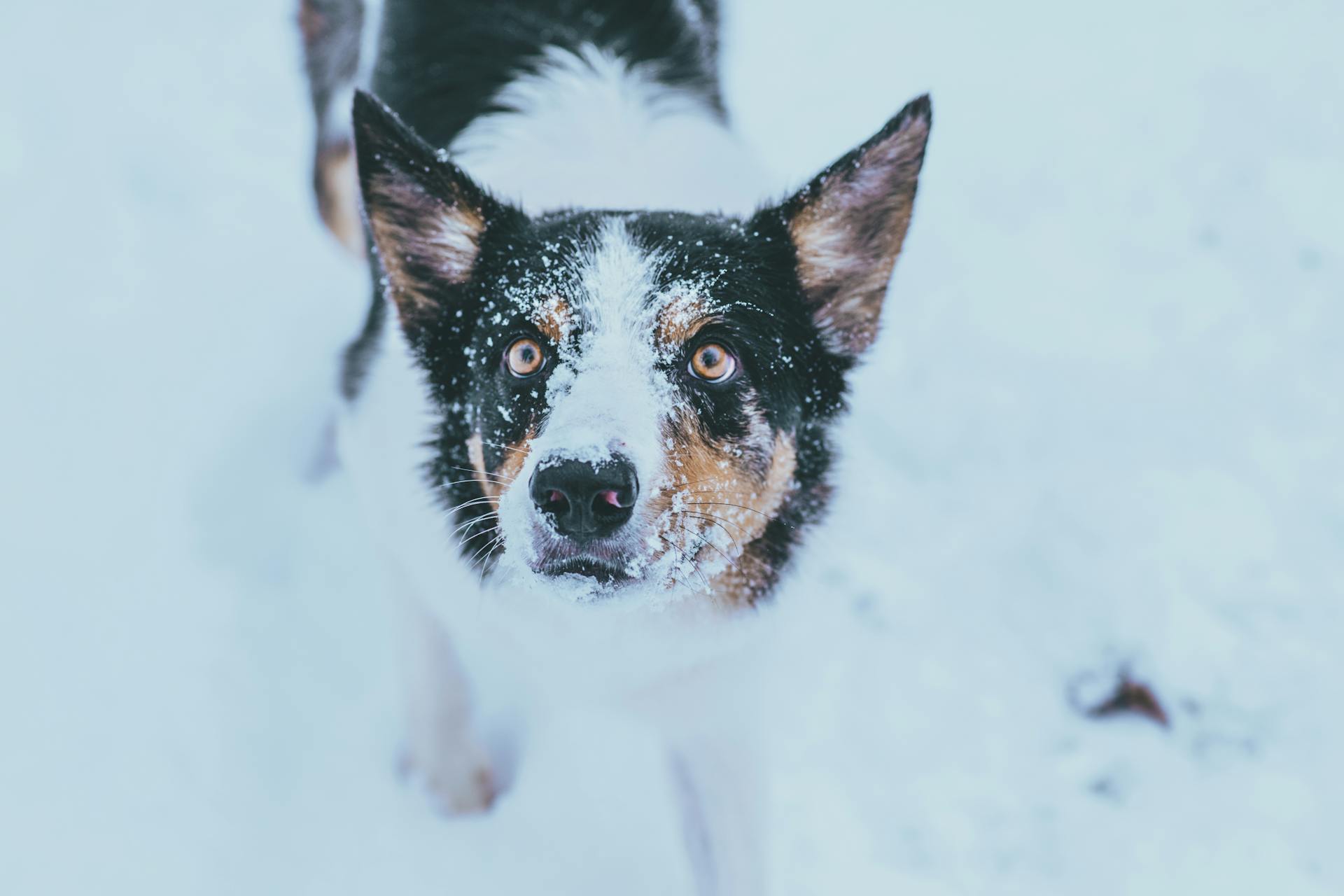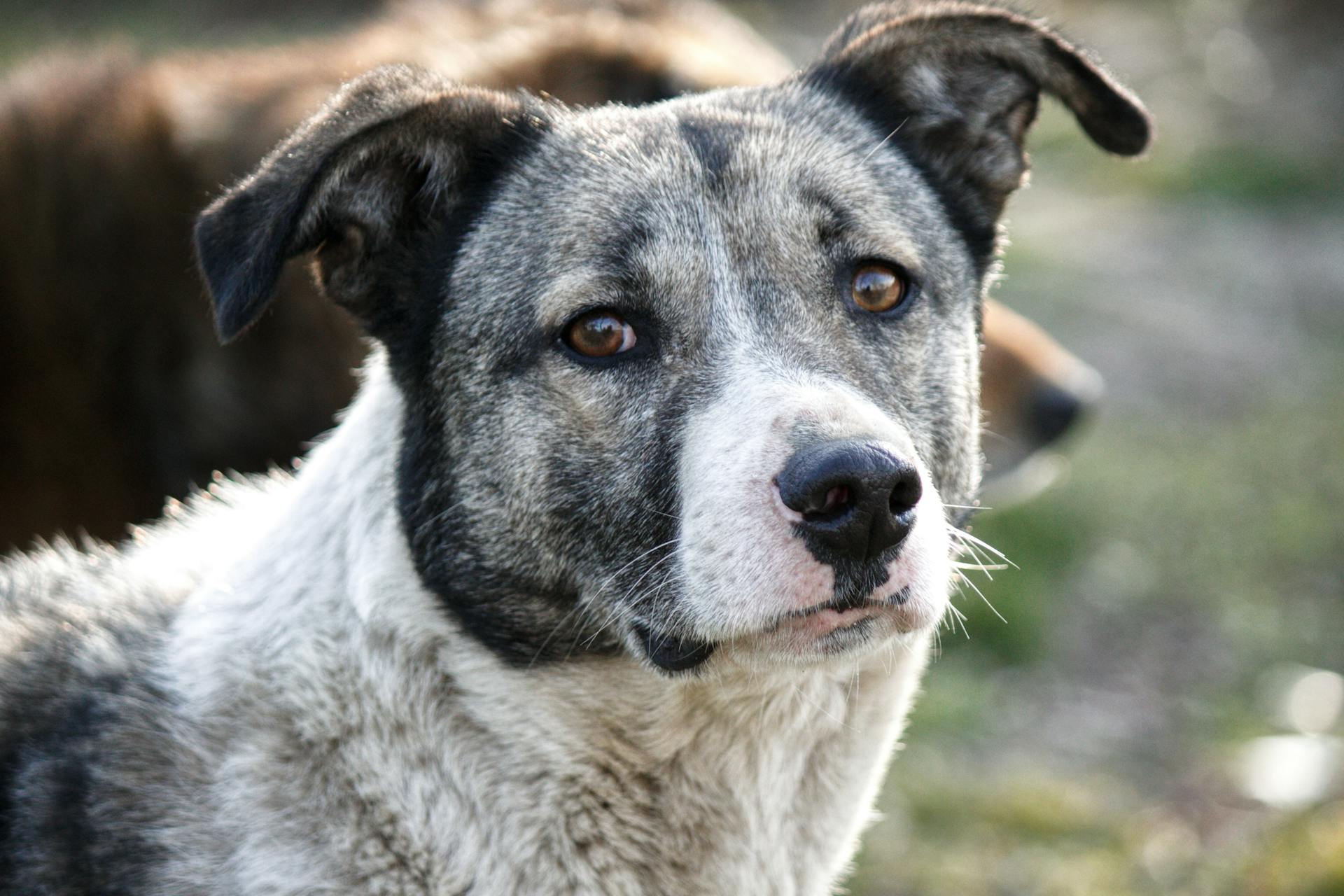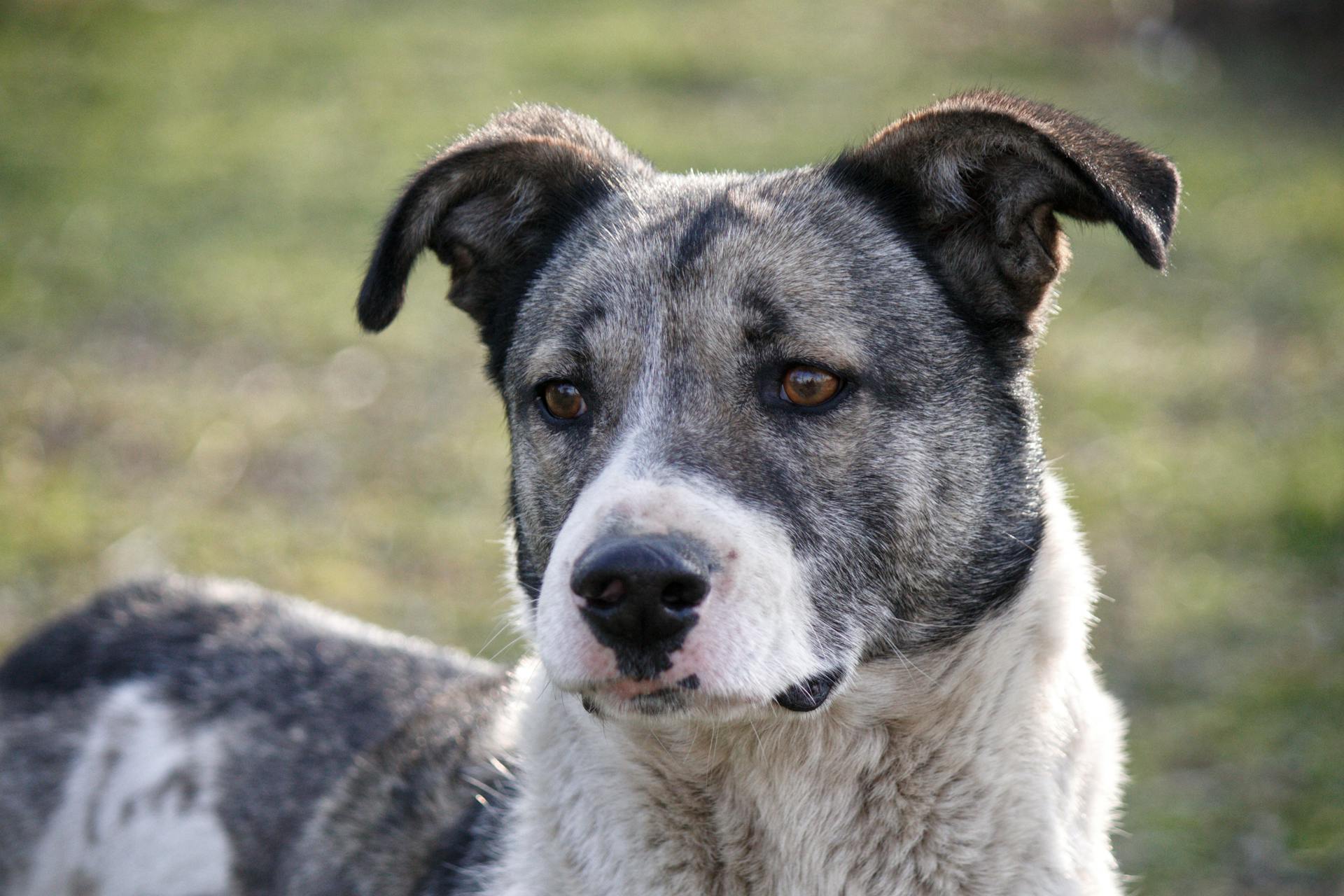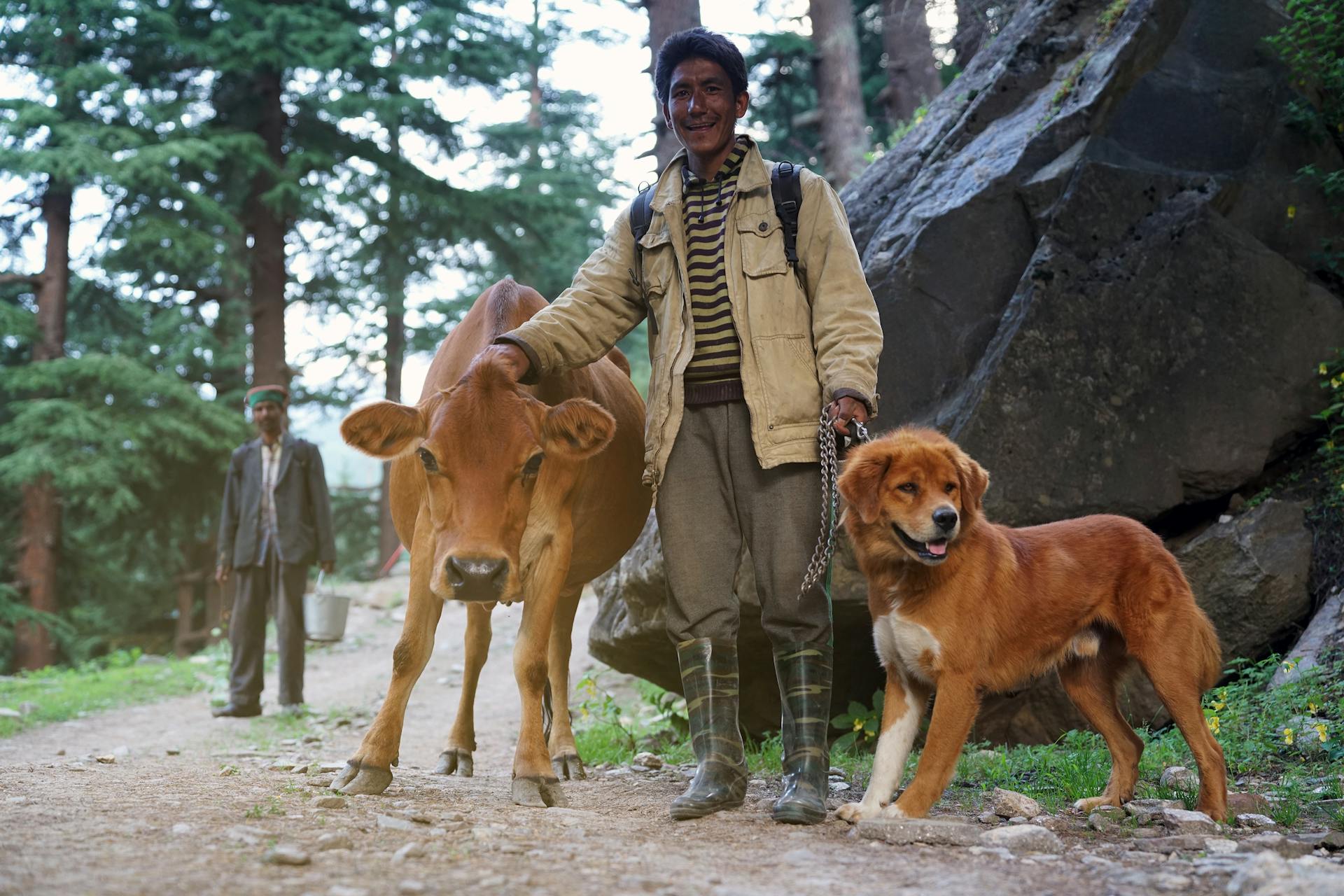
The Blue Heeler is a beloved breed for many dog enthusiasts. They originated in Australia in the 19th century.
Their ancestors were a mix of Dingo and other breeds, including the Collie and the Dalmatian. This unique combination gave the Blue Heeler its distinctive characteristics.
Blue Heelers are medium-sized dogs, typically weighing between 30-50 pounds. They have a short, smooth coat that comes in a variety of colors, including blue, red, and black.
Breed Information
The Blue Heeler breed is a medium-sized dog with a strong and energetic personality. They are known for being alert, intelligent, and loyal.
Their intelligence is one of their best qualities, making them easy to train and quick to learn new commands. They also have problem-solving skills, which can sometimes get them into trouble if they're not given enough mental stimulation.
In terms of exercise, Blue Heelers need a lot of physical activity to keep them happy and healthy. A large yard is essential to provide them with space to run around and play.
Here are some key characteristics of the Blue Heeler breed:
- Size: Medium
- Traits: Alert, intelligent, energetic, strong, loyal
- Maintenance: Low maintenance
- Best Suited To: Families, Farmers
Overall, Blue Heelers make great family pets and are loyal companions, but they do require regular exercise and mental stimulation to prevent boredom and destructive behavior.
Information and Pictures
The breed in question originated in the 19th century.
They were first bred as a working dog, specifically for herding livestock.
Their original purpose is still evident in their strong herding instincts today.
Their short coats require minimal grooming, making them a great choice for busy owners.
They are generally healthy, but can be prone to certain health issues.
Regular exercise and a balanced diet can help prevent these issues.
Their high energy levels make them a great fit for active families.
They are highly intelligent and trainable, but can be stubborn at times.
Consistent training and positive reinforcement are key to successful training.
Check this out: Blue Heeler Health Issues
Breed
The Australian Cattle Dog, also known as the Blue Heeler, is a medium-sized breed with a strong and athletic build.
They are known for their intelligence, making them easy to train, and their problem-solving skills are impressive. One of the most notable characteristics of this breed is their high energy levels, which require regular exercise to keep them happy and healthy.
Here's an interesting read: Pure Breed Boxer
The Blue Heeler's original purpose was to herd cattle, and they still have a strong herding instinct today. This can sometimes manifest as them trying to herd children, cats, or other pets, so it's essential to train them properly.
Here are some key breed characteristics:
- Size: Medium
- Traits: Alert, intelligent, energetic, strong, loyal
- Maintenance: Low maintenance
- Best Suited To: Families, Farmers
Their loyalty is unmatched, and they will protect their families at all costs. This loyalty can sometimes make them wary of strangers, so socialization is crucial from an early age.
The Blue Heeler's grooming needs are minimal, requiring only a weekly brush to remove loose hair and dirt. They should only be bathed when necessary, as over-bathing can strip their coat of its natural oils.
Overall, the Australian Cattle Dog is a remarkable breed that requires attention, exercise, and training to thrive. With proper care, they can make wonderful companions for active families or farmers.
History
The Australian Cattle Dog, also known as the Blue Heeler, was originally bred to herd livestock in Australia in the 19th century.
Thomas Hall is credited with creating the Halls Heeler, one of the ancestors of the Australian Cattle Dog, by crossing the Collie with the Australian Dingo.
The breed was well established by around 1890 and was first introduced to the United States in the 1940s.
The nickname "Heeler" arose because of their tendency to nip at cattle's heels to encourage movement while herding.
They were bred to herd cattle over long distances and possess special characteristics such as high energy levels and stamina.
The Blue Heeler has two different types: the Original Cattle Dog from New South Wales and the Queensland Heeler, a variant from the 1940s.
Robert Kaleski took up breeding Blue Heelers in 1893 and drew up a standard for the breed in 1897, basing it on the Dingo.
The Kennel Club of New South Wales approved this standard in 1903, and the breed was later known as the Australian Cattle Dog.
In May 1980, the Australian Cattle Dog was accepted for registration by the American Kennel Club, and it became eligible for show in the Working Group in September of that year.
A unique perspective: Images of Australian Cattle Dogs
Physical Characteristics
The Blue Heeler is a medium-sized breed that stands between 17 and 20 inches tall. Males are usually a few inches taller than females. Their weight can range between 35 to 50 pounds, with males and females weighing the same.
Their athletic build is characterized by a broad head, powerful jaw, and sloping shoulders. They have strong forelegs and muscular hind legs, making them well-suited for their working roles.
Here are the specific height and weight ranges for Blue Heelers:
Appearance
The Blue Heeler is a medium-sized breed that typically stands between 17 and 20 inches tall, with males usually a few inches taller than females.
Their weight can range between 35 to 50 pounds for both males and females, and they usually reach their full size and weight by around 18 months of age.
They are very athletic and muscular, with a broad head and powerful jaw. Their ears are set apart on the top of their head, much like a German Shepherd's ears.
Here are the specific height and weight ranges for Blue Heelers:
Their tail can be docked if they are working dogs in the US, but in the UK and Australia and Canada, they are kept at their full length to help with maneuverability.
Size
The Australian Cattle Dog is a medium-sized breed. Males stand 18 to 20 inches tall.
Females, on the other hand, are slightly smaller, standing between 17 to 19 inches tall.
Their weight range is quite impressive, spanning from 30 to 50 pounds.
Health and Care
Blue Heelers are generally healthy, but like all breeds, they're prone to certain health conditions. One of the most common issues is Progressive Retinal Atrophy (PRA), which causes gradual deterioration of the retina, leading to night-blindness and eventually complete blindness.
Hip Dysplasia is another inherited condition that can cause arthritis, especially as the dog ages. If you're buying a puppy, make sure to ask the breeder for proof that the parents have been tested for hip dysplasia and are free of problems.
Deafness is also a concern in Blue Heelers, particularly in dogs with white coats or roaning patterns. You can test for deafness in puppies using Brainstem Auditory Evoked Response (BAER) testing.
Some common health problems in Blue Heelers include Canine Hip Dysplasia, Progressive Retinal Atrophy, and Deafness. If you notice any signs of limping, pain, or impaired vision, it's essential to consult a veterinarian.
To keep your Blue Heeler healthy, provide them with proper nutrition, including a balanced diet and joint supplements if needed. They require a lot of physical and mental stimulation, so make sure to provide them with a securely fenced yard or engage them in canine sports.
Here are some key health concerns to watch out for in Blue Heelers:
- Progressive Retinal Atrophy: causes gradual deterioration of the retina
- Canine Hip Dysplasia: causes arthritis and limping
- Deafness: particularly in dogs with white coats or roaning patterns
Health
Blue heelers are generally healthy dogs, but like all breeds, they can be prone to certain health issues. One of the main concerns is hip dysplasia, which is a condition where the thighbone doesn't fit snugly into the hip joint.
Hip dysplasia can cause pain and lameness in some dogs, but others may not show any outward signs of discomfort. X-ray screening is the most certain way to diagnose the problem, and dogs with hip dysplasia should not be bred.
You might enjoy: How Smart Are Blue Heeler Dogs

Another health issue that can affect blue heelers is progressive retinal atrophy, a family of eye diseases that involves the gradual deterioration of the retina. Early in the disease, affected dogs become night-blind, and they may lose sight during the day as the disease progresses.
Deafness is also a concern in blue heelers, and it's often linked to their coat color. Research indicates that genes that cause pups to be born white or with white hairs in the coat are linked to deafness.
To keep your blue heeler healthy, it's essential to provide proper nutrition. As active dogs, they need a balanced diet that includes enough calories to keep up with their energetic lifestyles. You can use commercial dog food diets, but if your blue heeler is a working dog or spends hours sprinting and running, you may need to switch to a performance diet.
Here are some common health problems that can affect blue heelers:
- Hip Dysplasia: Signs include limping, "bunny hopping", avoidance of physical activity, and stiffness.
- Progressive Retinal Atrophy: An eye condition involving retinal deterioration leading to impaired vision.
- Deafness: Blue heelers are at risk for a genetic predisposition to deafness, indicated by a lack of responsiveness to sound, jumpiness, and unusual fits of barking.
By being aware of these potential health issues, you can take steps to prevent or manage them. Regular check-ups with your veterinarian and a balanced diet can go a long way in keeping your blue heeler happy and healthy.
Care

The Australian Cattle Dog needs plenty of physical and mental stimulation to thrive. He's not suited for apartment living or being left alone for long periods.
A securely fenced yard or a country farm or ranch is ideal for this breed. Without proper exercise, he'll become destructive and chew everything in sight.
Early socialization and training are crucial for this breed. If not properly socialized, he can become timid.
Blue Heelers love living in homes with a fenced yard or a safe property to run in. They need an outlet for their energy to prevent boredom and destruction.
Don't leave your Blue Heeler alone for long periods, especially in small spaces. Bring him along on walks, hikes, or swims to keep him happy and engaged.
If this caught your attention, see: History of the Blue Heeler
Temperament and Behavior
The Australian Cattle Dog, also known as the Blue Heeler, is a loyal and sweet-natured dog that loves to be by their owner's side.
They have a high activity level and need constant mental and physical activity to prevent boredom and destructive behavior. This can be achieved through regular exercise, training, and playtime.
The Blue Heeler is a working dog with a high prey drive, which means they can be known to chase things, but their intelligence makes them easy to train. They'll thrive in an environment where they have something to do.
They can be protective of their family and territory, but they're unlikely to show aggression towards humans unless they feel threatened. However, they may be hostile towards other dogs they don't know.
Socialization is key to ensuring your Blue Heeler grows up to be a well-rounded dog. This includes exposing them to many different people, sights, sounds, and experiences from an early age.
They can exhibit herding behaviors around small and young children, due to their herding nature, and may nip at them while playing. But with proper socialization, they can learn to behave around children.
The Blue Heeler is a devoted dog that bonds strongly with their owner and family, and punishment to them is physical separation from those they love.
They're smart, but can be willful and stubborn at times, requiring consistent, positive training to control their independent streak.
If you're considering bringing a Blue Heeler into your family, be prepared to keep them busy and tired, as they're prone to destructive behavior if bored or lonely.
Discover more: Blue Heeler Herding Cattle
Daily Life and Needs
Daily life with a purebred Blue Heeler is an active one. They need about 60 to 90 minutes of exercise a day to stay happy and healthy.
One or two walks a day are a must, with a total duration of at least 60 to 90 minutes. This breed loves to walk, hike, and swim, so finding time for outdoor activities is essential.
To keep your Blue Heeler engaged and satisfied, provide a variety of puzzles, chews, and tug toys. This will help channel their herding instincts and prevent boredom, which can lead to destructive behavior.
Daily Life
Living with a Blue Heeler can be a thrilling experience. Blue Heelers are high-energy dogs that require regular exercise to stay happy and healthy.
They need at least 30 minutes of intense physical activity every day, which can be achieved through running, hiking, or playing fetch.
Blue Heelers are intelligent dogs that thrive on mental stimulation and training. They require regular exercise to prevent boredom and destructive behavior.
Their short coats require minimal grooming, but they do need regular nail trimming and ear cleaning to stay healthy.
Blue Heelers are loyal and loving companions that make great family pets. They are naturally protective of their families and can be wary of strangers.
Worth a look: Red Blue Heeler Mix Dogs
Exercise Needs

Exercise is a critical part of a blue heeler's life. They need at least 60 to 90 minutes of exercise a day, preferably split into two walks.
Blue Heelers love to walk, hike, and swim, so they'll do best with people who are outside a lot and exercising. They don't do well when cooped up at home.
A 30-minute walk is a good starting point, but they also need opportunities to run around and an outlet for their herding instincts. They can get bored if they don't get enough physical and mental stimulation.
You can keep your dog entertained with a treat-dispensing puzzle or a rubber toy filled with peanut butter or another treat.
Feeding
Feeding is a crucial part of your Australian Cattle Dog's daily life, and it's essential to get it right. Recommended daily amount is between 1.5 to 2.5 cups of high-quality dry food a day, divided into two meals.

Your dog's size, age, build, metabolism, and activity level all play a role in determining how much food he needs. Dogs are individuals, just like people, and they don't all need the same amount of food.
To keep your Australian Cattle Dog in good shape, measure his food and feed him twice a day rather than leaving food out all the time. This will help prevent overeating and maintain a healthy weight.
If you're unsure whether your dog is overweight, give him the eye test and the hands-on test. You should be able to see a waist, and when you place your hands on his back, you should be able to feel but not see his ribs without having to press hard.
Weekly ear checks are also important to prevent infections. Wipe his ears out with a cotton ball dampened with gentle, pH-balanced ear cleaner, but don't insert anything into the ear canal.
For your interest: Best Food for Blue Heeler
Training and Grooming
Blue Heelers are highly intelligent and energetic dogs that thrive on structure and mental stimulation. They are relatively easy to train, especially when started at a young age.
Positive reinforcement training, which includes verbal rewards and treats, is highly effective for Blue Heelers. They pick up things quickly, but may require consistent training to stop unwanted behaviors.
Establishing a strong bond with your Blue Heeler is crucial, and training is a great way to do this. Early socialization and training can prevent behaviors like nipping at running kids or playing too rough with other animals.
Blue Heelers have a short double coat that requires minimal grooming. They only need to be brushed once a week with a slick brush to remove loose undercoat, and their nails should be trimmed every few weeks.
If this caught your attention, see: Training Blue Heeler
Training
Blue Heelers are easy to train because they're intelligent and love to work. They pick up things quickly, making training a breeze.
Start training your Blue Heeler from a young age to make the process much easier. With a strong prey drive and one track mind, they can get distracted easily.
Positive reinforcement training is key, using verbal rewards and treats to encourage good behavior. This helps to stop unwanted behaviors like herding and nipping.
Early socialization and training are crucial to help your Blue Heeler understand what behaviors are unacceptable. This includes not nipping at running kids or playing too rough with other animals.
The time spent training and interacting with your Blue Heeler stimulates their mind and develops the bond between you and your pet.
Suggestion: Blue Heeler Training Commands
Grooming
Blue Heelers don't require a lot of grooming, but they do need regular brushing to remove loose undercoat.
Brushing your Blue Heeler once a week with a slick brush will help keep their coat clean and prevent matting.
You'll also need to clip their nails every so often to keep them from getting too long, and brush their teeth as frequently as possible to prevent build up of decay that could lead to gum disease.
Feeding them dental sticks and crunchy kibble can also help keep their teeth clean.
Establishing a grooming routine from a young age can make all the difference in getting your Blue Heeler used to being groomed.
The Australian Cattle Dog sheds once or twice a year, but you'll need to brush them frequently during this time to remove the dead hair.
Brushing their teeth at least two or three times a week will help remove tartar buildup and prevent gum disease.
Trimming their nails once a month will keep their feet in good condition, and daily brushing is even better if you want to prevent bad breath.
Regular grooming will also help you spot potential health problems early, like sores, rashes, or signs of infection.
You can start getting your Australian Cattle Dog used to being groomed from a young age by handling their paws frequently and looking inside their mouth.
Related reading: Cow Dog Mix
Frequently Asked Questions
Are blue heeler dogs good pets?
Blue Heelers are loyal and intelligent dogs that make great family pets, but their high energy levels require regular exercise and attention. If you're up for the challenge, a Blue Heeler can be a loving and devoted companion.
What is the lifespan of a blue heeler?
Blue Heelers typically live between 12 to 15 years, but with proper care, some can live much longer.
Featured Images: pexels.com


